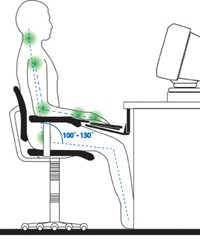If you are a science nerd like me you may have heard of Newton’s Third Law, “For every action there is an equal and opposite reaction.” In massage, for each muscle (group) there is an equal and opposite muscle (group). (Doesn’t have quite the same ring to it as Newton’s law does it?). What does this mean for you? If you are one of the millions of people who work in a sedentary environment, office workers and truck drivers for example, it mans your body is playing a game of tug of war throughout the day.
The grand prize? Your posture.
As our minds start to focus on the tasks of our work day we push what is going on with our bodies to the back of our thoughts. We may lean a little closer to the screen to focus in on our tasks. We might slouch a bit as we realize our “to do” pile is larger than our “done” pile. All the while, our bodies are trying to “help us” by shortening the muscles we are utilizing continuously throughout the day to help us maintain whatever pose we’ve placed our bodies in. Typically, these muscles are located on the ventral (front) side of the body and include the anterior neck, chest, abdominal, and hip flexing muscles. In response to this, the dorsal (back) side of the body tries to pull the torso and neck back into neutral. However, the stronger (and posturally reinforced) ventral muscles have all of the proverbial robe. The ventral muscles aren’t about to give it back either.
This tug of war can wreak havoc, leading to neck, shoulder, and back pain. So, how do you break the cycle? Movement breaks throughout the day, stretching, and massage can help to even the scales. (Cunha, Burk, Franca, & Marques, 2008)
- Ask your massage therapist about massage to the anterior neck, chest, abdomen, and hips.
- Take short movement breaks throughout the workday by getting up to refill your water bottle, or just take a lap around the office.
- Ask your PT or personal trainer about stretching muscles that can become shortened during a long workday in one position.
Reference: Cunha ACV, Burke TN, França FJR, Marques AP. (2008). Effect of global posture reeducation and of static stretching onto pain, range of motion, and quality of life in women with chronic neck pain: a random clinical trial. Clinics, 63, 763-70.
Written By: Jessica Silverman Mai.

